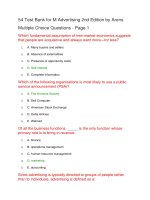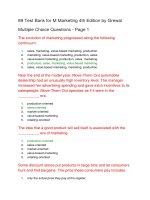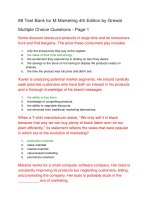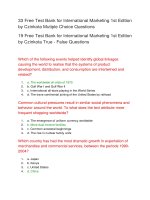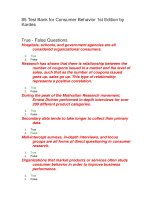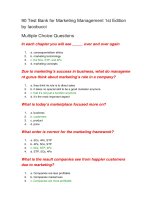Test bank for business statistics 1st edition by donnelly
Bạn đang xem bản rút gọn của tài liệu. Xem và tải ngay bản đầy đủ của tài liệu tại đây (71.89 KB, 17 trang )
Business Statistics (Donnelly)
Chapter 1 Introduction to Business Statistics
1) Statistics is the mathematical science that deals with the collection, analysis, and presentation of data–data
that can then be used as a basis for inference and induction.
Answer: TRUE
Diff: 1
Keywords: introduction to statistics
Reference: Page 2
2) Business statistics are statistics applied to the business world in an effort to improve people's decision
making in fields such as marketing, operations, finance, and human resources.
Answer: TRUE
Diff: 1
Keywords: introduction to statistics
Reference: Page 2
3) Information is the basic foundation for the field of statistics and can be defined as the value assigned to a
specific observation or measurement.
Answer: FALSE
Diff: 1
Keywords: data
Reference: Page 3
4) One of the major reasons to use statistics is to transform data into information.
Answer: TRUE
Diff: 1
Keywords: introduction to statistics
Reference: Page 3
5) An employee records the number of customers that arrive at a retail store today. This is an example of
collecting information.
Answer: FALSE
Diff: 2
Keywords: data
Reference: Page 3
6) Primary data is data collected by the person or organization that eventually uses the data.
Answer: TRUE
Diff: 1
Keywords: primary data
Reference: Page 4
7) Asking customers at the shopping mall about their voting intentions in the upcoming political election is an
example of secondary data.
Answer: FALSE
Diff: 1
Keywords: primary data
Reference: Page 4
1-1
Copyright © 2013 Pearson Education, Inc. Publishing as Prentice Hall
Full file at />
8) Analyzing unemployment data from the Bureau of Labor Statistics is an example of using secondary data.
Answer: TRUE
Diff: 1
Keywords: secondary data
Reference: Page 4
9) A hotel employee asks customers who are checking out to rate their satisfaction on a scale of 1-10. This is an
example of collecting primary data.
Answer: TRUE
Diff: 1
Keywords: primary data
Reference: Page 4
10) Analyzing snowfall amounts in New York over the past 100 years to help predict future weather patterns is
an example of using primary data.
Answer: FALSE
Diff: 1
Keywords: secondary data
Reference: Page 4
11) Bias can occur in a survey when a question is stated in a way that encourages or leads a respondent to a
particular answer.
Answer: TRUE
Diff: 1
Keywords: survey, bias
Reference: Page 5
12) A restaurant manager randomly selects tables at which customers have just been seated and records the
amount of time it takes for the wait staff to greet these customers. This is an example of an experiment being
used to collect data.
Answer: FALSE
Diff: 1
Keywords: direct observation
Reference: Page 5
13) A marketing research employee randomly selects adults in a shopping mall and asks them what type of car
that they drive. This is an example of using direct observation to collect data.
Answer: FALSE
Diff: 1
Keywords: surveys
Reference: Page 5
14) A manager of an electronics store would like to investigate the impact that price has on the demand for
laptop computers. Each week, the price of a Dell laptop is adjusted and the demand for each week is recorded.
This is an example of an experiment being used to collect data.
Answer: TRUE
Diff: 1
Keywords: experiments
Reference: Page 5
1-2
Copyright © 2013 Pearson Education, Inc. Publishing as Prentice Hall
Full file at />
15) To help ensure good questionnaire design, it is recommended that a survey is tested on a small group of
respondents before releasing it to the actual participants.
Answer: TRUE
Diff: 1
Keywords: surveys
Reference: Page 5
16) It is recommended that personal demographic questions be placed at the beginning of the questionnaire
because respondents find these questions easy to answer.
Answer: FALSE
Diff: 2
Keywords: surveys
Reference: Page 6
17) Interval data deals strictly with qualitative data assigned to predetermined categories.
Answer: FALSE
Diff: 1
Keywords: nominal data
Reference: Page 6
18) Education level is an example of nominal data.
Answer: TRUE
Diff: 1
Keywords: nominal data
Reference: Page 6
19) Nominal data has all the features of interval data with the added benefit of having a true zero point.
Answer: FALSE
Diff: 1
Keywords: ratio data
Reference: Page 8
20) The interval measurement level is considered quantitative data.
Answer: TRUE
Diff: 1
Keywords: interval data
Reference: Page 8
21) The ratio measurement level is considered qualitative data.
Answer: FALSE
Diff: 1
Keywords: ratio data
Reference: Page 8
22) The number of pages in your business statistics textbook is an example of quantitative data.
Answer: TRUE
Diff: 1
Keywords: quantitative data
Reference: Page 6
1-3
Copyright © 2013 Pearson Education, Inc. Publishing as Prentice Hall
Full file at />
23) Your cell phone number is an example of quantitative data.
Answer: FALSE
Diff: 1
Keywords: qualitative data
Reference: Page 6
24) A respondent to a survey indicates that she drives a Ford Taurus. This is an example of qualitative data.
Answer: TRUE
Diff: 1
Keywords: qualitative data
Reference: Page 6
25) A respondent to a survey indicates that he has lived in his current residence for three years. This is an
example of qualitative data.
Answer: FALSE
Diff: 1
Keywords: qualitative data
Reference: Page 6
26) The mathematical operation of addition can be performed on nominal data.
Answer: FALSE
Diff: 2
Keywords: nominal data
Reference: Page 6
27) The mathematical operation of multiplication can be performed on interval data.
Answer: FALSE
Diff: 2
Keywords: interval data
Reference: Page 6
28) All mathematical operations can be performed on ratio data.
Answer: TRUE
Diff: 2
Keywords: ratio data
Reference: Page 8
29) The purpose of inferential statistics is to summarize or display data.
Answer: FALSE
Diff: 1
Keywords: descriptive statistics
Reference: Page 11
30) The purpose of inferential statistics is to make claims or conclusions about a population based on a sample.
Answer: TRUE
Diff: 1
Keywords: inferential statistics
Reference: Page 11
1-4
Copyright © 2013 Pearson Education, Inc. Publishing as Prentice Hall
Full file at />
31) A limitation of descriptive statistics is that, by summarizing large quantities of data, you lose information.
Answer: TRUE
Diff: 1
Keywords: descriptive statistics
Reference: Page 11
32) Predicting election results by asking voters their intentions is an example of descriptive statistics.
Answer: FALSE
Diff: 1
Keywords: inferential statistics
Reference: Page 11
33) Deciding that a process that fills bottles with soda is functioning properly by checking the weights for a
sample of bottles is an example of inferential statistics.
Answer: TRUE
Diff: 1
Keywords: inferential statistics
Reference: Page 11
34) Calculating the average time callers wait on the phone for technical support is an example of inferential
statistics.
Answer: FALSE
Diff: 1
Keywords: descriptive statistics
Reference: Page 11
35) Determining the proportion of customers who have credit scores greater than 700 is an example of
descriptive statistics.
Answer: TRUE
Diff: 1
Keywords: descriptive statistics
Reference: Page 11
36) An unbiased sample is a sample that does not represent the intended population and can lead to
distorted findings. Unbiased sampling can occur either intentionally or unintentionally.
Answer: FALSE
Diff: 2
Keywords: biased sample
Reference: Page 13
37) Statistics can be misused by making differences seem greater or lesser by adjusting the scale on graphs.
Answer: TRUE
Diff: 1
Keywords: misusing statistics
Reference: Page 14
1-5
Copyright © 2013 Pearson Education, Inc. Publishing as Prentice Hall
Full file at />
38) Collecting data about the television viewers for the Summer Olympics is an example of using statistics in
the field of ________.
A) marketing research
B) advertising
C) operations
D) finance
Answer: B
Diff: 1
Keywords: uses of business statistics
Reference: Page 2
39) Using income data to determine the credit worthiness of a consumer who wishes to purchase a new car is an
example of using statistics in the field of ________.
A) marketing research
B) advertising
C) operations
D) finance
Answer: D
Diff: 1
Keywords: uses of business statistics
Reference: Page 3
40) Gathering information from potential customers in an effort to determine their preferences is an example of
using statistics in the field of ________.
A) marketing research
B) advertising
C) operations
D) finance
Answer: A
Diff: 1
Keywords: uses of business statistics
Reference: Page 2
41) Using quality control techniques to test the salt content of pretzels before they are packaged for the
consumer is an example of using statistics in the field of ________.
A) marketing research
B) advertising
C) operations
D) finance
Answer: C
Diff: 1
Keywords: uses of business statistics
Reference: Page 3
1-6
Copyright © 2013 Pearson Education, Inc. Publishing as Prentice Hall
Full file at />
42) ________ is (are) derived from facts for the purpose of making decisions.
A) Data
B) Information
C) Statistics
D) Samples
Answer: B
Diff: 1
Keywords: uses of business statistics
Reference: Page 3
43) The main drawback to using secondary data is that
A) it may be expensive to obtain the data.
B) the subjects of interest need to be directly observed to collect the data.
C) the subjects of interest are paid to provide the data.
D) you have no control over how the data were collected.
Answer: D
Diff: 1
Keywords: sources of data
Reference: Page 4
44) A method of gathering data when subjects are exposed to certain treatments and the data of interest is
recorded is known as
A) direct observation.
B) focus groups.
C) experiments.
D) surveys.
Answer: C
Diff: 1
Keywords: experiments
Reference: Page 5
45) A method of gathering data when people are asked a series of questions that can be administered by e-mail,
via the Web, face-to-face or over the telephone, is known as
A) direct observation.
B) focus groups.
C) experiments.
D) surveys.
Answer: D
Diff: 1
Keywords: surveys
Reference: Page 5
1-7
Copyright © 2013 Pearson Education, Inc. Publishing as Prentice Hall
Full file at />
46) A method of gathering data while the subjects of interest are in their natural environment, often unaware
they are being watched, is known as
A) direct observation.
B) focus groups.
C) experiments.
D) surveys.
Answer: A
Diff: 1
Keywords: direct observation
Reference: Page 5
47) A method of gathering data when individuals are paid to discuss their attitudes towards products or services
in a group setting controlled by a moderator is known as
A) direct observation.
B) focus groups.
C) experiments.
D) surveys.
Answer: B
Diff: 1
Keywords: focus groups
Reference: Page 5
48) A telemarketer calls individuals at home over the phone and ask them the likelihood that they will purchase
a timeshare property over the next 12 months. This method of gathering data is known as
A) direct observation.
B) focus groups.
C) experiments.
D) surveys.
Answer: D
Diff: 1
Keywords: surveys
Reference: Page 5
49) A Bank of America employee records the amount of time that customers spend using the ATM machine at
her branch. This method of gathering data is known as
A) direct observation.
B) focus groups.
C) experiments.
D) surveys.
Answer: A
Diff: 1
Keywords: direct observation
Reference: Page 5
1-8
Copyright © 2013 Pearson Education, Inc. Publishing as Prentice Hall
Full file at />
50) The manager at the local Ruby Tuesday's restaurant wanted to investigate the effect of music on the average
revenue per customer. Each night for one month, fast-paced music was played. The following month, slowpaced music was played every night. The average revenue per customer for each month was compared. This
method of gathering data is known as
A) direct observation.
B) focus groups.
C) experiments.
D) surveys.
Answer: C
Diff: 1
Keywords: experiments
Reference: Page 5
51) A marketing manager for a textbook publisher meets with a group of several students who are paid to
discuss what they like and dislike about their textbooks. This method of gathering data is known as
A) direct observation.
B) focus groups.
C) experiments.
D) surveys.
Answer: B
Diff: 1
Keywords: focus groups
Reference: Page 5
52) ________ data use numerical values to describe something of interest either by measuring it or counting it.
A) Primary
B) Secondary
C) Quantitative
D) Qualitative
Answer: C
Diff: 1
Keywords: quantitative data
Reference: Page 6
53) ________ data use descriptive terms to measure or classify something of interest.
A) Primary
B) Secondary
C) Quantitative
D) Qualitative
Answer: D
Diff: 1
Keywords: qualitative data
Reference: Page 6
1-9
Copyright © 2013 Pearson Education, Inc. Publishing as Prentice Hall
Full file at />
54) Which of the following is an example of quantitative data?
A) the zip code of your home address
B) Apple's closing stock price today
C) your gender
D) your telephone number
Answer: B
Diff: 1
Keywords: qualitative data
Reference: Page 6
55) Which of the following is an example of qualitative data?
A) today's high temperature
B) the class average of your last statistics exam
C) the amount of time that you studied for your last statistics exam
D) your last name
Answer: D
Diff: 1
Keywords: quantitative data
Reference: Page 6
56) Which levels of measurement are considered quantitative data?
A) interval and ratio
B) nominal and interval
C) nominal and ratio
D) nominal and ordinal
Answer: A
Diff: 1
Keywords: quantitative data
Reference: Page 8
57) Which levels of measurement are considered qualitative data?
A) interval and ratio
B) nominal and interval
C) ordinal and ratio
D) nominal and ordinal
Answer: D
Diff: 1
Keywords: qualitative data
Reference: Page 8
58) The number of iPhones sold today at an Apple store is an example of
A) nominal data.
B) ordinal data.
C) interval data.
D) ratio data.
Answer: D
Diff: 1
Keywords: ratio data
Reference: Page 9
1-10
Copyright © 2013 Pearson Education, Inc. Publishing as Prentice Hall
Full file at />
59) A respondent of a survey indicates that he is a resident in the state of Ohio. This is an example of
A) nominal data.
B) ordinal data.
C) interval data.
D) ratio data.
Answer: A
Diff: 1
Keywords: nominal data
Reference: Page 6
60) The Graduate Management Admission Test (GMAT) is a standardized test used by schools to determine the
aptitude of individuals who are applying for MBA programs. The range of the GMAT score is 200-800. Brian
has recently taken the exam and scored 720. This is an example of
A) nominal data.
B) ordinal data.
C) interval data.
D) ratio data.
Answer: C
Diff: 1
Keywords: interval data
Reference: Page 7
61) In a Major League Baseball game today, the Philadelphia Phillies scored six runs against the New York
Mets. This is an example of
A) nominal data.
B) ordinal data.
C) interval data.
D) ratio data.
Answer: D
Diff: 1
Keywords: ratio data
Reference: Page 9
62) A respondent of a survey indicates that she is currently in her junior year at the University of Texas. This is
an example of
A) nominal data.
B) ordinal data.
C) interval data.
D) ratio data.
Answer: B
Diff: 1
Keywords: ordinal data
Reference: Page 7
1-11
Copyright © 2013 Pearson Education, Inc. Publishing as Prentice Hall
Full file at />
63) A car dealership performs a credit check on a potential customer. According to the credit bureau, the
customer's credit score is 710. This is an example of
A) nominal data.
B) ordinal data.
C) interval data.
D) ratio data.
Answer: C
Diff: 1
Keywords: interval data
Reference: Page 7
64) A respondent of a survey indicates that he owns the home that he currently resides. This is an example of
A) nominal data.
B) ordinal data.
C) interval data.
D) ratio data.
Answer: A
Diff: 1
Keywords: nominal data
Reference: Page 6
65) A respondent of a survey is asked whether their most recent dining experience was excellent, good, fair, or
poor. The person indicates that the experience was "good". This is an example of
A) nominal data.
B) ordinal data.
C) interval data.
D) ratio data.
Answer: B
Diff: 1
Keywords: ordinal data
Reference: Page 7
66) A property of ________ data is that the differences between categories are not meaningful and, therefore,
cannot be measured.
A) cross-sectional
B) ordinal
C) interval
D) ratio
Answer: B
Diff: 1
Keywords: ordinal data
Reference: Page 7
1-12
Copyright © 2013 Pearson Education, Inc. Publishing as Prentice Hall
Full file at />
67) ________ data has the benefit of a true zero point.
A) Nominal
B) Ordinal
C) Interval
D) Ratio
Answer: D
Diff: 1
Keywords: ratio data
Reference: Page 8
68) ________data are values that correspond to specific measurements taken over a range of time periods.
A) Cross-sectional
B) Ordinal
C) Time series
D) Ratio
Answer: C
Diff: 1
Keywords: time series data
Reference: Page 9
69) ________ data are values collected from a number of subjects (firms, individual, states, regions, and so
forth) during a single time period.
A) Cross-sectional
B) Ordinal
C) Time series
D) Ratio
Answer: A
Diff: 1
Keywords: cross-sectional data
Reference: Page 10
1-13
Copyright © 2013 Pearson Education, Inc. Publishing as Prentice Hall
Full file at />
70) The following table shows the number of televisions sold at the local Best Buy store over the past seven
days.
Day
Monday
Tuesday
Wednesday
Thursday
Friday
Saturday
Sunday
Number Sold
5
9
5
7
12
19
15
Which of the following data types best describe these values?
A) cross-sectional
B) nominal
C) time series
D) ordinal
Answer: C
Diff: 1
Keywords: time series data
Reference: Page 9
71) The following table shows the stock price for Google at the end of the past four quarters.
Quarter
2
3
4
1
Year
2011
2011
2011
2012
Stock Price
$506
$515
$646
$641
Which of the following data types best describe these values?
A) cross-sectional
B) nominal
C) time series
D) ordinal
Answer: C
Diff: 1
Keywords: time series data
Reference: Page 9
1-14
Copyright © 2013 Pearson Education, Inc. Publishing as Prentice Hall
Full file at />
72) The following table shows the number of televisions sold at the local Best Buy store last week according to
brand.
Brand
Samsung
Sony
Toshiba
LG
Vizio
Number Sold
15
12
9
16
11
Which of the following data types best describe these values?
A) cross-sectional
B) nominal
C) time series
D) ordinal
Answer: A
Diff: 1
Keywords: cross-sectional data
Reference: Page 10
73) The following table shows the number of people, in thousands, in the United States at various levels of
household income in 2010.
Household Income
Less than $25,000
$25,000 to $49,999
$50,000 to $74,999
$75,000 or more
Number of People
60,140
70,680
57,359
117,931
Which of the following data types best describe these values?
A) cross-sectional
B) nominal
C) time series
D) ordinal
Answer: A
Diff: 1
Keywords: cross-sectional data
Reference: Page 10
74) Your business statistics class had an exam last week. The average exam score for the class is an example of
A) secondary data.
B) qualitative data.
C) descriptive statistics.
D) inferential statistics.
Answer: C
Diff: 1
Keywords: descriptive statistics
Reference: Page 11
1-15
Copyright © 2013 Pearson Education, Inc. Publishing as Prentice Hall
Full file at />
75) The proportion of customers that rate their latest airline experience as "excellent" is an example of
A) secondary data.
B) qualitative data.
C) descriptive statistics.
D) inferential statistics.
Answer: C
Diff: 1
Keywords: descriptive statistics
Reference: Page 11
76) General Mills is considering offering a new type of yogurt. To gauge interest, they are performing taste tests
at different locations around the country. Based on the results of these samples, they will decide whether or not
to market the new yogurt. This is an example of using
A) secondary data.
B) qualitative data.
C) descriptive statistics.
D) inferential statistics.
Answer: D
Diff: 1
Keywords: inferential statistics
Reference: Page 11
77) Bridgestone would like to estimate the average tread life of a particular brand of automobile tire. Fifty
customers who have purchased this tire are sampled and asked about the tread life of their tires. This is an
example of using
A) secondary data.
B) qualitative data.
C) descriptive statistics.
D) inferential statistics.
Answer: D
Diff: 1
Keywords: inferential statistics
Reference: Page 11
78) Holiday Inn would like to estimate the satisfaction level of its customers. A sample of 25 hotels were
selected and the customers at these locations were asked to rate their experience on a scale of 1-10. Based on
this sample data, Holiday Inn will draw a conclusion about the satisfaction level of their customers. This is an
example of using
A) secondary data.
B) qualitative data.
C) descriptive statistics.
D) inferential statistics.
Answer: D
Diff: 1
Keywords: inferential statistics
Reference: Page 11
1-16
Copyright © 2013 Pearson Education, Inc. Publishing as Prentice Hall
Full file at />
79) According to climate data recorded since 1884, the average annual snowfall in Philadelphia is 22.3 inches.
This value is an example of
A) biased data.
B) qualitative data.
C) descriptive statistics.
D) inferential statistics.
Answer: C
Diff: 1
Keywords: descriptive statistics
Reference: Page 11
80) A ________ represents all possible subjects of interest.
A) sample
B) population
C) statistic
D) parameter
Answer: B
Diff: 1
Keywords: population
Reference: Page 11
81) A ________ is a portion of a population that is representative of the population from which it is selected.
A) sample
B) survey
C) statistic
D) parameter
Answer: A
Diff: 1
Keywords: sample
Reference: Page 11
82) Data that describe a characteristic about a population is known as a ________.
A) sample
B) survey
C) statistic
D) parameter
Answer: D
Diff: 1
Keywords: parameter
Reference: Page 13
83) Data that describe a characteristic about a sample is known as a ________.
A) population
B) survey
C) statistic
D) parameter
Answer: C
Diff: 1
Keywords: statistic
Reference: Page 13
1-17
Copyright © 2013 Pearson Education, Inc. Publishing as Prentice Hall
Full file at />
